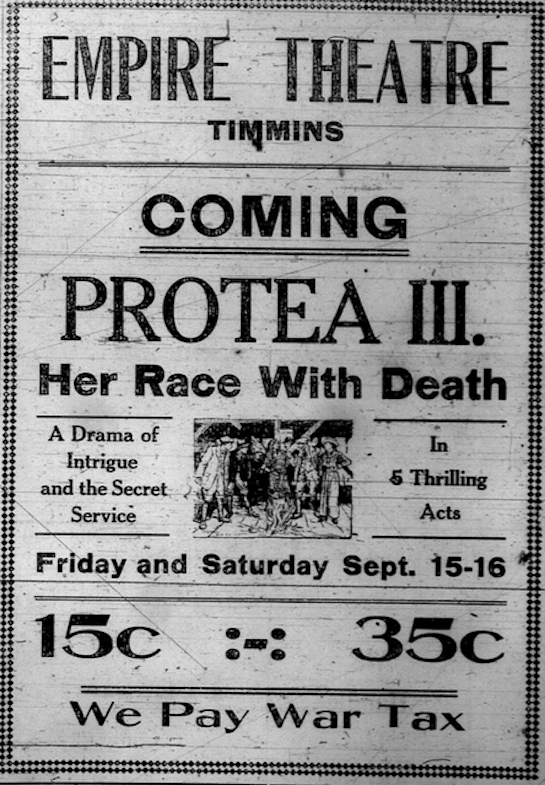 Jessica Whitehead, a PHD student from Toronto is researching the history of locally owned movie theatres in the Timmins and Porcupine gold camp from its beginning in 1909 until their closures.
Jessica Whitehead, a PHD student from Toronto is researching the history of locally owned movie theatres in the Timmins and Porcupine gold camp from its beginning in 1909 until their closures.
Jointly supervised by York University and Ryerson her project is titled Movie Going on the Margins: The History of Film Exhibition in Timmins, Ontario, and will focus on the Empire Theatre chain founded by Leo Mascioli.
“Movies were important for the social life of Timmins from the beginning, because of the efforts of Leo Mascioli, the man Hollinger employed to bring mine workers from Italy,” Whitehead explained.
Whitehead’s own roots in North Ontario inspired her interest.
Whitehead was born in Sudbury and her maternal grandparents (Bellini) were from Timmins.
Timmins was established in 1912 and emerged out of the Porcupine gold rush of 1909.
Many of the residents were immigrant labourers from Europe who worked at the Hollinger Mine.
“Once settled in Timmins the men needed to be housed, fed and entertained,” Whitehead added. “Mascioli started exhibiting films in the gold camps at the back of his grocery store in 1912.”
“The first modern movie theatre in Timmins was the New Empire Theatre, built in 1916 on Third Ave.,” Whitehead noted. “Other theatres existed before, this was the first modern theatre.”
Along with Charlie Chaplin films, vaudeville shows featuring Tom Marx were popular in 1916.
Marx performed live preceding the screening of a film such as The Master Key.
Another film that was played in 1916 was Protea: Race to the Death.
Birth of a Nation, a controversial movie even to this day was shown in Timmins in 1917.
The Empire chain expanded in Timmins and the north east starting with the Goldfield, the Palace in 1936 and then into Schumacher, South Porcupine, New Liskeard and Kapuskasing.
Whitehead’s research includes reviewing old newspaper articles and interviewing people who went to the movies at the Empire Theatres as far back as the 1930s.
By the 1930s Famous Players Canadian Corporation, owned by Paramount Pictures, began taking over the independent theatre chains.
The Empire chain withstood the efforts and in 1937 signed a partnership agreement with Famous Players.
The agreement provided for building the Victory Theatre in Timmins in exchange for Famous Players getting the rights to the Quintland Theatre in North Bay.
“The theatres continued to thrive during the depression because they were affordable,” said Whitehead. “The Palace Theatre, a true movie palace, was built in 1936."
One of the most beloved movies during the 1930s was Gone with the Wind.
“Gone with the Wind was particularly loved,” Whitehead said, “and was brought back in the late 1940s.”
During World War II, the Empire Theatres faced a major challenge when its owner Leo Mascioli was temporarily interned after Italy declared war on the British Empire.
But the Empire Theatres prospered and Mascioli was exonerated.
“One reason was that they showed newsreels and it was a way to keep informed about the war.”
The Greatest Show on Earth and The Sound of Music were two of the more popular movies to be screened in Timmins after World War II.
Theatres also provided live entertainment.
A young Sammy Davies Jr. performed in Timmins as did the Von Trapp family, whose life is the subject of The Sound of Music.
Theatres as were also used for religious services and graduations as well as beauty pageants.
With the rise of television, theatres began to decline and close.
But the buildings remain after being converted to other uses.
The Empire is a senior’s centre; The Cartier and the Broadway are restaurants.
The Victory is a bar, the Goldfields is a condo and the Palace is a shopping complex.
Whitehead’s research will lead to a chapter in a book about rural cinema later in 2015.
She also plans to either publish a book or produce a film documentary based on her research.



